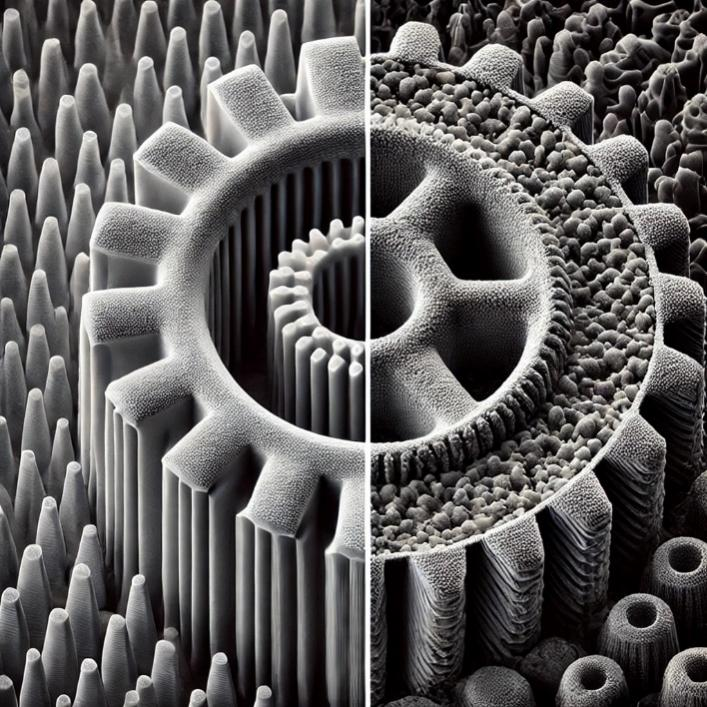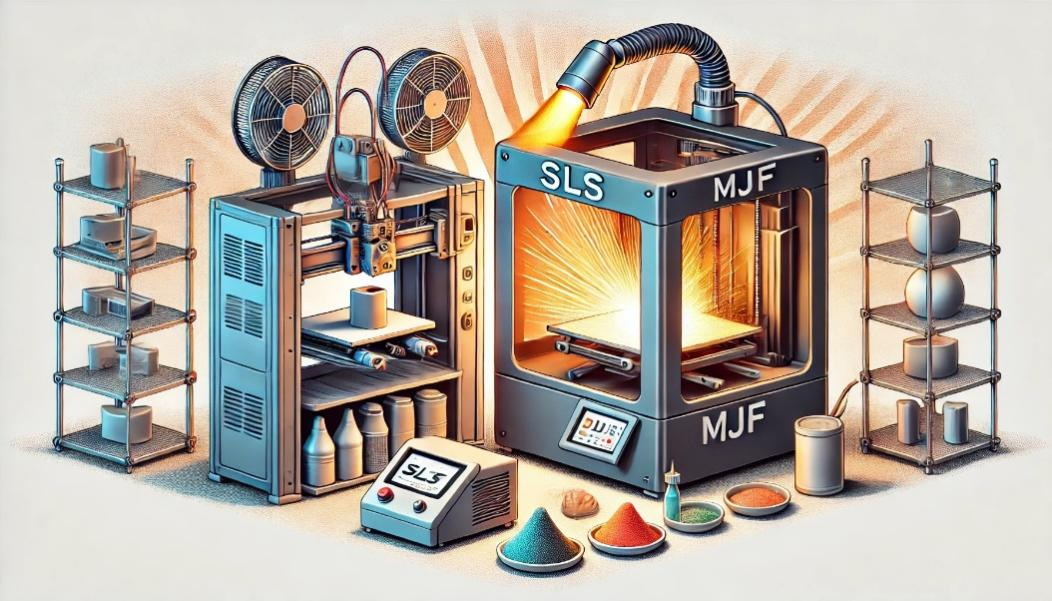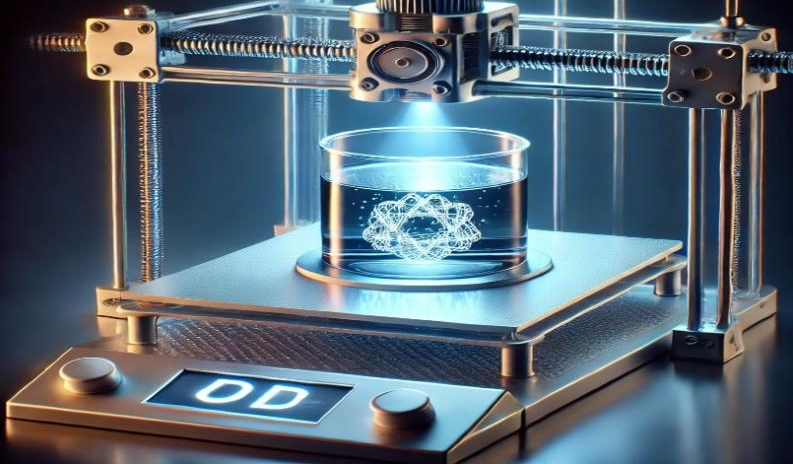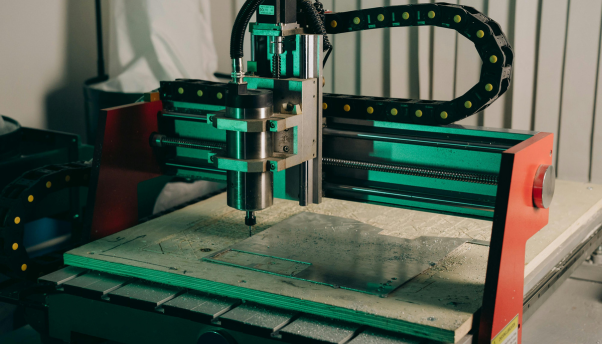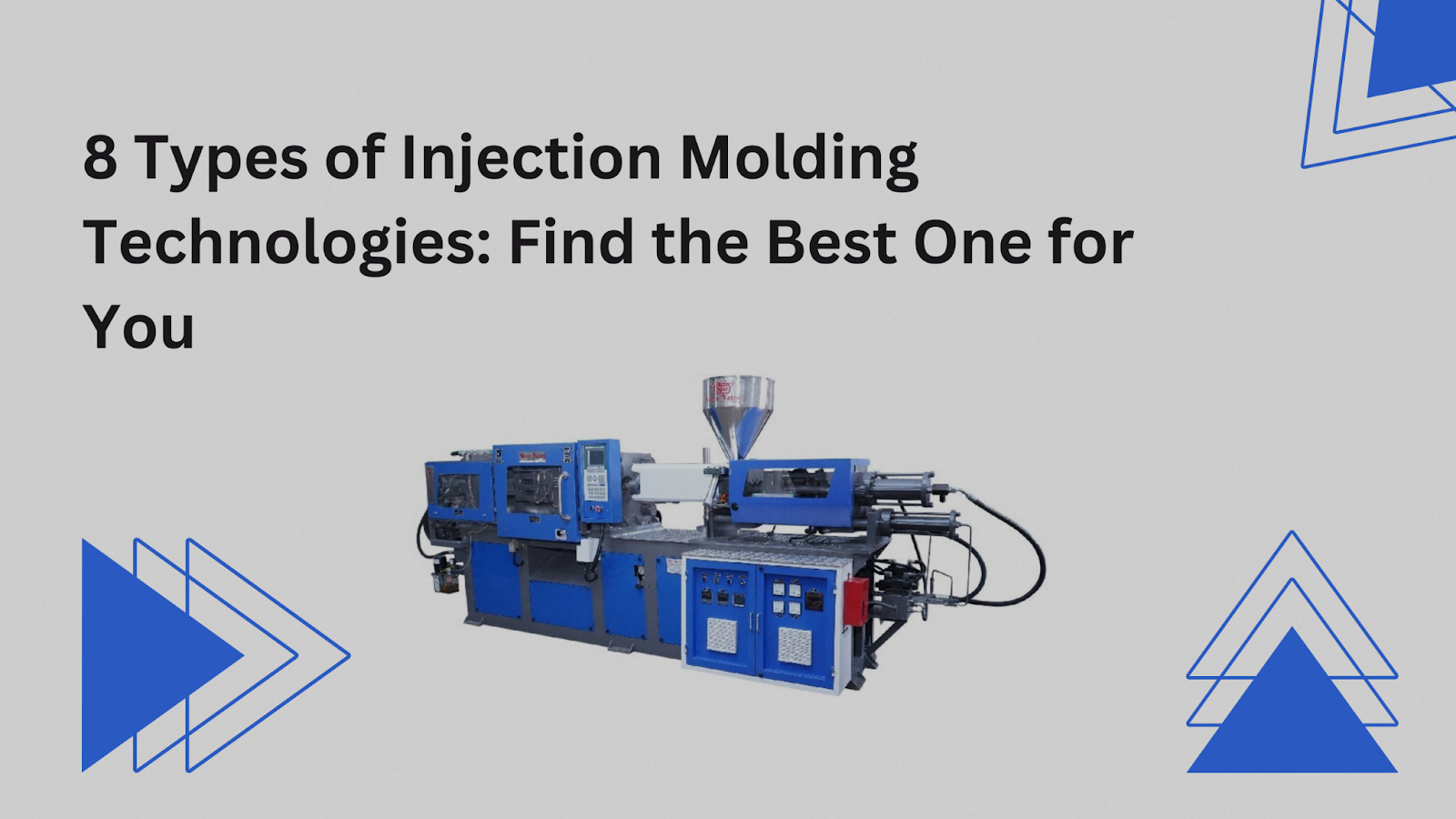Introduction
The difference between MJF and SLS is not just about how they print but also how their parts differ in quality, speed, and material options. Multi Jet Fusion (MJF) and Selective Laser Sintering (SLS) are both powder-based 3D printing methods, but they operate differently. While MJF is generally faster and produces parts with smoother surfaces and higher isotropic strength, SLS offers more material choices and is well-suited for complex geometries.
This guide breaks it all down: Multi Jet Fusion vs SLS materials, durability, processing time, and real-world applications. By the end, you’ll know exactly which one works best for your application.
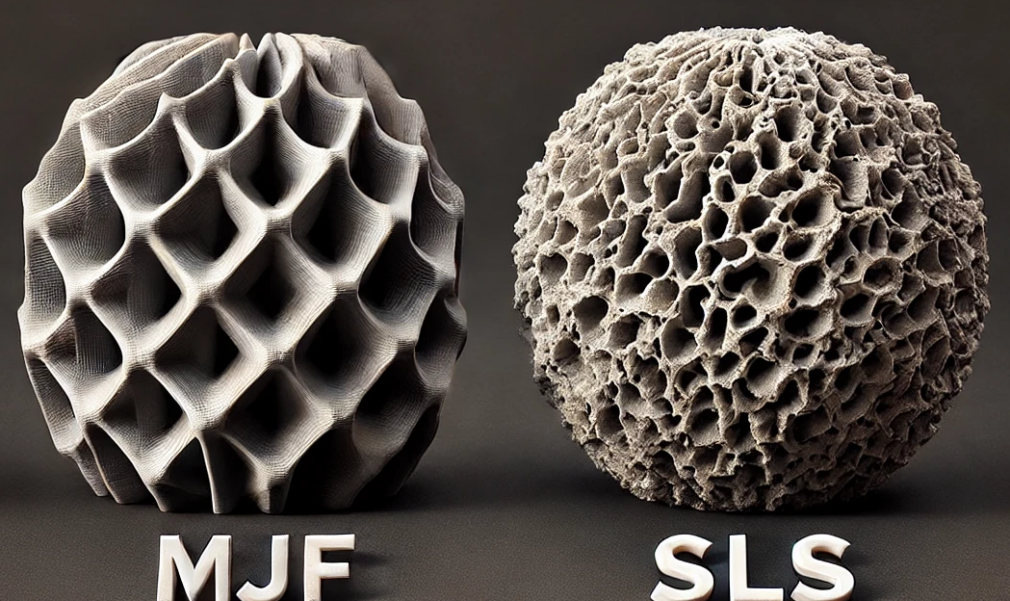
An Introduction to MJF and SLS 3D Printing Technologies
The difference between MJF and SLS isn’t just technical. It’s practical. These two powder-based technologies are favorites in industrial 3D printing, but they work differently. Manufacturers often debate Multi Jet Fusion vs. SLS when looking for functional, durable, and cost-efficient parts.
Conceptually speaking, MJF first sprays a fusing agent onto the powder and then uses infrared heating to fuse the particles together. In contrast, SLS employs a laser to sinter the powder, causing the particles to bond without fully melting. These distinct processes influence speed, surface quality, material flexibility, and cost. Understanding the advantages and limitations of SLS and MJF will help you choose the right technology for your project.
What is SLS 3D Printing?
Selective Laser Sintering (SLS) is a laser-driven 3D printing method. It takes fine polymer powder and sinters it—layer by layer—with a high-powered laser. The result? Strong, functional prototypes and end-use parts. Since no support structures are needed, SLS is ideal for intricate geometries.
Key Advantages & Disadvantages of SLS 3D Printing
| ✅ Advantages | ❌ Disadvantages |
| Material Variety – Works with Nylon 11, Nylon 12, TPU, offering flexibility and strength. | Rough Surface Finish – Post-processing like bead blasting is often required. |
| No Support Structures – Easily prints complex, interlocking designs without material waste. | Slower Print Speed – Takes longer compared to MJF vs. SLS 3D printing speeds. |
| High Mechanical Strength – Durable and ideal for functional testing and load-bearing parts. | Higher Powder Waste – Unfused powder degrades after multiple uses, reducing recyclability. |
What is MJF 3D Printing?
MJF doesn’t use lasers. Instead, it jets a fusing agent onto a bed of powder, and then applies heat to solidify the material. The result? Faster prints, finer details, and smoother surfaces—without sacrificing the strength.
Key Advantages & Disadvantages of MJF 3D Printing
| ✅ Advantages | ❌ Disadvantages |
| Faster Production – Prints significantly faster than SLS, ideal for rapid manufacturing. | Limited Material Selection – Primarily supports PA 12 and PA 11, while SLS offers more polymer choices. |
| Smoother Surface Finish – Produces less roughness, reducing post-processing time and cost. | Cooling Sensitivity – Requires precise cooling to prevent warping and inconsistencies. |
| High Detail Resolution – Delivers sharp edges, fine features, and excellent accuracy. | Higher Equipment Cost – MJF printers tend to be more expensive than SLS machines. |
Multi Jet Fusion vs. SLS – Which is the Better Choice?
It’s not about which is “better” overall—it’s about which is better for you.
✅ Need speed? Go with MJF.
✅ Want more material choices? SLS wins.
✅ Prioritizing strength? Both work, but SLS offers better heat resistance.
And if you’re wondering about SLS vs. SLA, here’s a quick tip: SLA prints smoother parts with liquid resin, but lacks the strength of SLS or MJF.
Comparisons Between MJF and SLS
When evaluating the difference between MJF and SLS, key factors like printing technology, material compatibility, surface quality, strength, and cost come into play.
Comparison Table: MJF vs SLS 3D Printing
| Feature | MJF 3D Printing | SLS 3D Printing |
| Technology | Fusing & detailing agents + heat | Laser sintering |
| Material Options | PA12, PA11, TPU, PP, glass-filled nylon | PA11, PA12, PA6, TPU, composites |
| Surface Finish | Smooth, uniform | Grainy, porous |
| Part Strength | Consistent, high tensile strength | Flexible, impact-resistant |
| Production Speed | Faster batch processing | Slower, layer-by-layer sintering |
| Print Volume | Ideal for high-volume production | Handles complex geometries well |
| Cost Efficiency | Lower per-unit cost for mass production | Higher due to longer processing times |
| Post-Processing | Minimal finishing needed | Extensive sanding, dyeing required |
Difference between MJF and SLS Materials
Material choice directly affects durability, flexibility, and chemical resistance. SLS supports a wider range, including composites and flexible TPU, making it a strong contender for impact-resistant parts. MJF, while slightly limited in variety, ensures greater consistency in mechanical properties, with PA12 and PA11 offering superior chemical resistance.
Difference between MJF and SLS Surface Finish
SLS prints typically have a grainy, porous texture, requiring post-processing like sanding or dyeing for smoothness. MJF, thanks to its fusing agent-based process, produces parts that are naturally smoother and more uniform, reducing the need for additional finishing.
Find out which process is better for high-quality 3D-printed keycaps: SLS or MJF?
Difference between MJF and SLS Strength
MJF and SLS both make tough, durable parts. No doubt about that. But the way they do it is where things get interesting.
MJF parts? Strong all around. No weak spots. That’s because it lays down a fusing agent evenly across each layer, bonding everything together in a dense, watertight structure. Same strength in every direction. Reliable.
SLS, on the other hand, plays by different rules. It sinters powder bit by bit using a laser, which means layer bonding isn’t always equal. Strength depends on print orientation. A part printed sideways might flex more than one printed upright. Take SLS PA: its elongation at break is 18% in the XY direction but drops to just 4% in the Z direction, indicating reduced flexibility along the vertical axis..
Difference between MJF and SLS Print Volume
Build volume matters. A lot. Especially when you’re churning out batches.
MJF is built for precision. Tight, compact, efficient. Most machines max out at around 380 x 284 x 380 mm—perfect for smaller, high-detail parts that need to be spot-on every time.
SLS plays a different game. Bigger. Bolder. Machines can range anywhere from 300 x 300 x 300 mm to 750 x 550 x 550 mm, depending on the setup. That means more room for larger parts or stacking up multiple pieces in one go. Plus, no need for support structure, ust let the unsintered powder do its thing.
Difference between MJF and SLS Processing Time
Speed matters. And MJF wins here.
It prints whole layers in one go—fusing agent, heat, done. No slow tracing, no wasted time. However, with SLS a laser painstakingly sinters each point, layer by layer and it takes longer.
Then comes cooling. MJF’s uniform heating means parts cool faster, ready to go sooner. But SLS needs extra time. Otherwise, warping happens. That wait adds up.
SLS Processing Time
SLS takes its sweet time. That’s because after printing, the parts can’t just be yanked out immediately, they need to cool down gradually, or they’ll warp.
- Longer cooling timesincrease overall processing time.
- Unfused powder surrounding the part acts as insulation, slowing heat dissipation.
- Post-processing—media blasting, dyeing, or vapor smoothing—adds extra hours.
Further Reading: What are the disadvantages of SLS?
MJF Processing Time
MJF? Much quicker. HP’s thermal control tech keeps heat exposure minimal, leading to faster part removal.
- Shorter cooling cycles mean parts are ready almost immediatelyafter printing.
- Less post-processing needed, thanks to naturally smooth surfaces.
- More parts in a single batch = faster overall production speed.
Difference between MJF and SLS Cost
If you’ve ever requested a quote for 3D printing, you already know—pricing can be a dealbreaker. Material cost, machine time, post-processing—it all adds up.
SLS leans on the expensive side. The CO₂ laser system alone is a costly piece of equipment, and then there’s the post-processing. However, MJF is more budget-friendly, especially for small-to-medium production runs as it does faster printing so has lower per-part cost for high-volume jobs.
How SLS and MJF 3D Printing Processes Operate
To really get the difference between MJF and SLS, you gotta see how each process works. Both belong to the powder bed fusion (PBF) family, but they handle heat, processing speed, and material bonding completely differently.
Before diving into the details, here’s a quick side-by-side comparison to highlight their key differences:
| Feature | SLS 3D Printing | MJF 3D Printing |
| Heat Source | CO₂ laser | Infrared heating |
| Fusion Method | Direct laser sintering | Fusing & detailing agents |
| Cooling Time | Longer (gradual cooling) | Shorter (controlled heating) |
| Post-Processing | More cleaning & finishing | Faster, less labor-intensive |
| Print Speed | Slower due to cooling | Faster with high throughput |
| Best For | Impact-resistant parts | Dense, watertight, precise parts |
Now, let’s break down how each of these 3D printing processes actually works.
SLS 3D Printing: How It Works
SLS has been around for decades, and there’s a reason manufacturer still love it—it’s reliable, scalable, and great for tough parts. But it’s not the fastest.
- Powder Distribution: A thin layer of powder (PA12, PA11, TPU) spreads evenly across the build platform. No need for support structures—unfused powder naturally holds parts in place, making intricate designs possible.
- Laser Sintering: A CO₂ laser selectively sinters the powder, fusing only the necessary areas. Unfused powder remains loose, allowing for complex, hollow geometries.
- Layer-by-Layer Printing:The build platform lowers, a fresh layer of powder spreads, and the laser repeats the sintering process—hundreds or even thousands of times. However, thermal inconsistencies can slightly impact surface finish.
- Cooling & Post-Processing:And then… you wait. Cooling takes hours because SLS parts sit inside a warm powder cake. Removing them too soon? Bad idea. Warping and shrinkage happen if heat isn’t evenly distributed. Once cooled, parts go through media blasting, dyeing, or vapor smoothing for a better finish.
MJF 3D Printing: How It Works
MJF isn’t just another powder-based printing tech—it’s a game-changer. Unlike SLS, which relies on a high-powered laser, MJF fuses powder using a combination of liquid agents and infrared heat. This not only speeds up production but also results in denser, smoother, and more watertight parts.
1. Powder Layering:
Just like SLS, MJF starts with a fine layer of Nylon PA12 or TPU powder spread across the build platform. But there’s a difference. MJF’s powder deposition is tightly controlled, leading to less waste and a more consistent print quality across the entire batch.
2. Using & Detailing Agents:
Now, this is where things get interesting. Instead of a laser sintering the material directly, MJF applies two liquid agents before the heating process even begins:
- Fusing agent: Applied where the powder needs to bond and solidify.
- Detailing agent: Keeps edges sharp by preventing excess heat from spreading.
This is why the difference between MJF and SLS is noticeable in final part quality, MJF controls heat more precisely, making it better for intricate designs and smoother finishes.
3. Infrared Heating & Layer Formation:
After the liquid agents are applied, infrared lamps sweep over the build area, activating the fusing agent and solidifying the layer in a single go. Because heat is distributed evenly, MJF parts maintain uniform strength across the entire print—no weak spots or inconsistent textures.
4. Rapid Cooling & Post-Processing
SLS takes its time cooling, but MJF? Not so much.
- Faster cooling = quicker part removal.No need for drawn-out cooling phases.
- Minimal thermal distortion.Parts don’t shrink or warp as easily.
- Less post-processing required.A quick clean-up, maybe some dyeing or polishing, and that’s it.
🔗 Wondering how this applies to keycaps? See what is the difference between MJF and SLS keycaps.
🔗 Looking for high-quality 3D-printed parts? Order MJF and SLS parts from Future Parts.
Exploring Alternatives to SLS and MJF 3D Printing
MJF and SLS are top choices for industrial 3D printing, no doubt. But they’re not always the perfect fit. Sometimes, factors like cost, material compatibility, or production needs lead to other options, such as FDM or SLA.
Comparing MJF, SLS, SLA, and FDM
| Feature | MJF | SLS | FDM | SLA |
| Material | Nylon powder | Nylon, TPU | PLA, ABS | Photopolymer resin |
| Speed | Fastest | Moderate | Slow | Slow |
| Finish | Smooth | Needs finishing | Layer lines visible | Smoothest |
| Strength | High | Strong but porous | Weakest | Brittle |
| Best For | Functional parts | Complex designs | Low-cost models | High-detail prints |
Now, let’s break down these alternative technologies in more detail.
1️ Fused Deposition Modeling (FDM): Affordable and Accessible
Unlike MJF vs SLS 3D printing, which use powder fusion, FDM melts thermoplastic filament and extrudes it layer by layer. It’s simple, cheap, and widely used in prototyping and hobby projects.
🔻 Limitations of FDM Compared to MJF and SLS
- Weaker Strength– FDM prints lack durability compared to MJF and SLS parts.
- Rougher Surface– Unlike MJF’s smooth finish, FDM parts need sanding.
- Less Design Flexibility– Needs support structures, unlike SLS, where powder supports intricate shapes.
For budget-friendly models, FDM works. But if you need precision, compare SLA vs. SLS for better results.
2️ Stereolithography (SLA): Precision and Smooth Surface Quality
If surface finish is a priority, SLA is the answer. Instead of powders or filaments, SLA uses photopolymer resins, cured by UV light, to create flawless, high-detail prints. Ideal for jewelry, dentistry, and miniatures.
Compared to Multi Jet Fusion vs SLS keycaps, SLA’s detail resolution is unmatched. But it’s not perfect.
🔻 Limitations of SLA Compared to MJF and SLS
- Lower Strength– SLA resins are brittle.
- Higher Material Costs– Photopolymer resins are pricier than SLS and MJF powders.
- Smaller Print Volume– Unlike MJF and SLS industrial machines, SLA has limited build size.
If you want perfect aesthetics, SLA is the best. But for stronger, functional parts? SLS or MJF is the way to go.
Want a deeper dive? Check out the what is the difference between MJF and SLS keycaps to see how material choice affects durability.
How to Choose the Right 3D Printing Technology
Too many options. Too many factors. SLS vs MJF
3D printing are both great, but is one actually better for you? Then there’s FDM and SLA—cheaper, but not always the right fit. So, what’s the right pick?
Well, it depends. Material properties, budget, speed, and final use matter more than you’d think. Whether you are questioning that what is MJF 3D printing or comparing SLS vs MJF, here’s how to make the best choice.
Key Factors to Consider When Choosing a 3D Printing Method
1️. Material Properties – Strength or Aesthetics?
Materials decide how strong, flexible, or durable your prints will be. Here’s what works best for different needs:
- MJF & SLS→ Nylon powders for strong, industrial-grade parts. Reliable.
- SLA→ Photopolymer resins. Smoothest finishes, but fragile. Ideal for dental, jewelry, or detailed models.
- FDM→ Thermoplastic filaments (PLA, ABS). Affordable, but not the strongest.
2️. Cost Considerations – What’s Your Budget?
Some 3D printing methods are pricier than others—but for good reason. Here’s a breakdown:
| Technology | Material Cost | Machine Cost | Best For |
| MJF | High | Expensive | Industrial, functional parts |
| SLS | High | Expensive | Strong, lightweight parts |
| FDM | Low | Affordable | Budget-friendly prototyping |
| SLA | Moderate | Expensive | High-detail, aesthetic models |
3️. Print Speed & Volume – Need It Fast?
- Multi Jet Fusion vs. SLS?MJF prints faster. No debate.
- FDM & SLA?Slower but cost-effective for small batch projects.
If production speed is your top priority, MJF wins for mass production.
Which 3D Printing Technology is Best for Your Industry?
Choosing between MJF vs SLS keycaps or looking for strong aerospace components? Industry matters.
| Industry | Recommended 3D Printing Method |
| Automotive | MJF & SLS (strong, durable parts) |
| Aerospace | SLS (lightweight, high-strength) |
| Medical | SLA & MJF (detailed, biocompatible) |
| Consumer Goods | FDM & MJF (affordable prototyping) |
For example, if you’re debating what is the difference between MJF and SLS keycaps, knowing which process best suits keycap design helps avoid wrong material choices.
Still unsure? Talk to our experts for a recommendation tailored to your project.
Order MJF and SLS Parts from Future Parts
Finding reliable 3D printing services can be a headache. Some places cut corners; others charge a fortune. But if you want high-quality MJF and SLS parts without the stress, Future Parts has you covered. We specialize in precision manufacturing, use top-tier materials, and offer competitive pricing.
Need durable nylon parts with SLS? Or fast, high-resolution prints with Multi Jet Fusion? Whatever the project, Future Parts delivers exactly what you need—with zero compromises.
Why Choose Future Parts for MJF and SLS 3D Printing?
1️. Real Expertise in MJF and SLS
Not all 3D printing providers truly understand difference between MJF and SLS manufacturing. Future Parts does.
2️. High-Quality Materials & Precision Manufacturing
No low-grade materials. No sloppy prints. Future Parts only works with premium-grade powders to ensure consistent durability and high-resolution details.
3️ Fair Pricing & Fast Turnaround
Most people think high-quality 3D printing means high costs. Not with Future Parts. We offer:
✔ Affordable pricing—without cutting corners.
✔ Fast turnaround times— as fast as in 1 day, so your project stays on track.
✔ Scalability—from one-off prototypes to full production runs. We can handle 3D printing of parts up to 24″ x 36″ x 36″ without requiring splitting or bonding.
To get your customized offer, you can get a quote from us!
More Than Just MJF & SLS:
Future Parts isn’t just about 3D printing. We offer a full suite of manufacturing solutions, including:
✅ CNC Machining – Precision metal and plastic parts made to spec.
✅ Injection Molding – Ideal for high-volume plastic part production.
✅ Vacuum Casting – For low-volume runs with exceptional detail.
How to Order from Future Parts
Ordering custom 3D printed parts shouldn’t be complicated. With Future Parts, it’s as easy as:
- Upload Your Design– Send your 3D model files for a quote.
- Pick the Best Printing Method– Not sure? Our experts help you choose between MJF vs SLS 3D printing based on your project’s needs.
- Get a Transparent Quote– No hidden fees. No surprises.
- Production & Fast Delivery – Once approved, your parts are printed and shipped—fast.
📩 Need expert advice? Reach out to Future Parts today and get your 3D printing project moving!
Conclusion
Picking the right 3D printing technology isn’t just about specs—it’s about what your project actually needs. The difference between MJF and SLS comes down to speed, material properties, and surface finish. SLS excels in durability and heat resistance, while MJF offers precision, smoother surfaces, and faster production.
If you’re looking for expert MJF or SLS 3D printing services, Future Parts has you covered. From prototypes to end-use production, we also offer SLA, FDM, CNC machining, and injection molding—whatever fits your needs 😊

